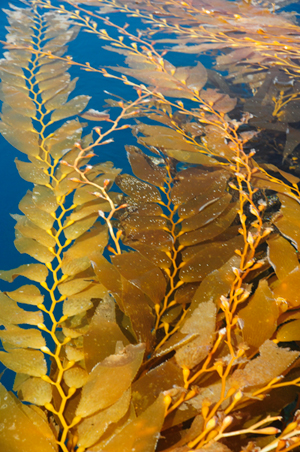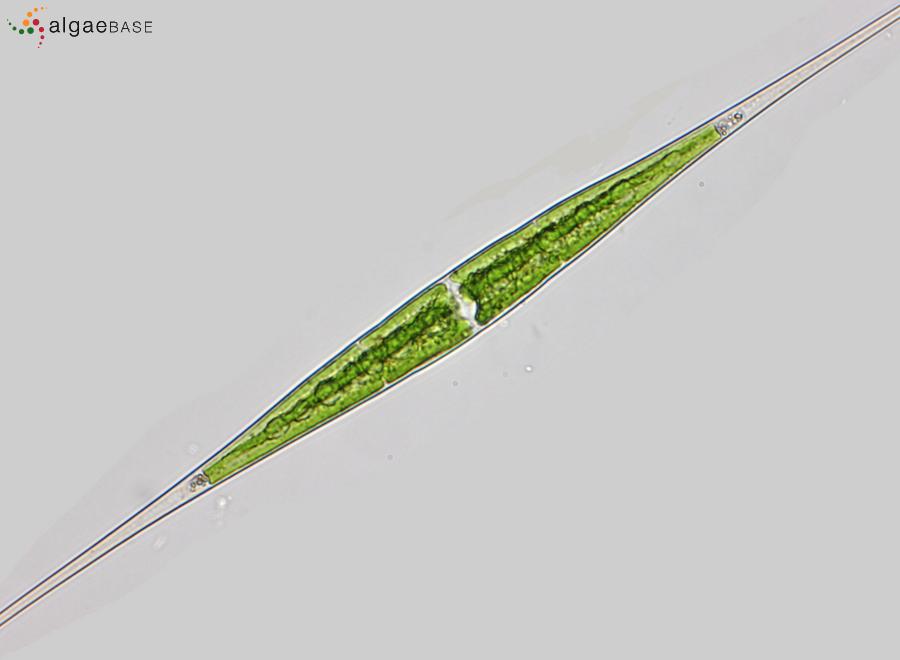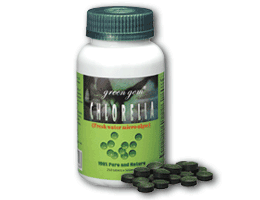The golden-brown algae include both the chrysophytes and the synurophytes. The motile chrysophytes are sometimes referred to as the chrysomonads. Both the chrysophytes and synurophytes are most abundant and diverse in freshwaters of neutral or slightly acidic pH with low conductivity, alkalinity, and nutrient levels and colder temperatures, but may also inhabit a variety of environments.
Chrysophytes and synurophytes are heterokonts in either the vegetative or reproductive stage. Heterokont cells have two unequal flagella. One is long, covered in two rows of tripartite hairs, and is located on the cell anterior, while the other is short, smooth, and directed laterally or posteriorly, perpendicular to the longer flagellum. The flagella may be covered in scales. The longer flagellum moves with a flat, S-shaped motion to propel unicellular organisms forward; the short flagellum beats helically to allow colonial forms to swim with a rotational motion.
Chrysophytes are both photosynthetic and heterotrophic. They may be phagotrophic – engulfing particulate matter such as bacteria or small algae, or osmotrophic – absorbing organic molecules. The long flagellum is used as a feeding apparatus in some species by directing the water current and food particles towards the cell. The unicellular genus Ochromonas is often considered the “model chrysophyte” with cellular morphology and function typical of the group.
The synurophytes, commonly called the scaled chrysophytes, are motile flagellates covered by siliceous scales. Each cell has one or two golden-colored chloroplasts and two parallel flagella that emerge from an anterior pore or from in between scales. This group lacks the pigment chlorophyll c2 seen in the chrysophytes, and relies on photosynthesis as their sole energy source since they have lost their mixotrophic abilities. Most species have different types of scales that are found in specific locations on the cell. The scales vary in form, but generally consist of a base plate with an upturned rim and often have domes, ribs, pores, or spines. The scale design is unique to a particular species and is used in identification. The synurophytes currently include only four genera. Mallomonas, Synura, and Chrysodidymus are found in North America, while Tessellaria is found only in Australia.
Like the siliceous remains of diatom cells, synurophyte scales persist in sediments and are valuable tools for paleolimnologists and ecologists interested in the changes in ecological conditions over time. The synurophytes are excellent bioindicators as they inhabit particular environmental niches and are especially sensitive to pH and the presence of pollutants. Many species are useful in long-term monitoring of water quality and environmental conditions, and species distributions along dissolved salt, trophic, and temperatures gradients are of great use to ecologists.
All synurophytes undergo a siliceous resting stage. Both sexual and asexual reproduction can produce a cyst, often in response to changes in environmental conditions or population density. Like the synurophyte scales, the hollow, rounded cysts are formed within silica deposition vesicles.
Source: http://silicasecchidisk.conncoll.edu/LucidKeys/Carolina_Key/html/Golden_browns.html

 The brown colour of these algae results from the dominance of the xanthophyll pigment fucoxanthin, which masks the other pigments, Chlorophyll a and c (there is no Chlorophyll b), beta-carotene and other xanthophylls. Food reserves are typically complex polysaccharides, sugars and higher alcohols. The principal carbohydrate reserve is laminaran, and true starch is absent (compare with the green algae). The walls are made of cellulose and alginic acid, a long-chained heteropolysaccharide.
The brown colour of these algae results from the dominance of the xanthophyll pigment fucoxanthin, which masks the other pigments, Chlorophyll a and c (there is no Chlorophyll b), beta-carotene and other xanthophylls. Food reserves are typically complex polysaccharides, sugars and higher alcohols. The principal carbohydrate reserve is laminaran, and true starch is absent (compare with the green algae). The walls are made of cellulose and alginic acid, a long-chained heteropolysaccharide. Most brown algae have an alternation of haploid and diploid generations. The haploid thalli form isogamous, anisogamous or oogamous gametes and the diploid thalli form zoospores, generally by meiosis. The haploid (gametangial) and diploid (sporangial) thalli may be similar (isomorphic) or different (heteromorphic) in appearance, or the gametangial generation may be extremely reduced (Fucales). The brown Giant Kelp
Most brown algae have an alternation of haploid and diploid generations. The haploid thalli form isogamous, anisogamous or oogamous gametes and the diploid thalli form zoospores, generally by meiosis. The haploid (gametangial) and diploid (sporangial) thalli may be similar (isomorphic) or different (heteromorphic) in appearance, or the gametangial generation may be extremely reduced (Fucales). The brown Giant Kelp  Examples: Chlorella,
Examples: Chlorella,  (motile spores). Sexual reproduction is very common and may be isogamous (gametes both motile and same size); anisogamous (both motile and different sizes – female bigger) or oogamous (female non-motile and egg-like; male motile). Many green algae have an alternation of haploid and diploid phases. The haploid phases form gametangia (sexual reproductive organs) and the diploid phases form zoospores by reduction division (meiosis). Some do not have an alternation of generations, meiosis occurring in the zygote. There are about 8,000 species of green algae, about 1,000 of which are marine chlorophytes and the remainder freshwater charophytes. Unfortunately, just because algae are green no longer means that they are related: two major aggregation of green algae, the Chlorophyta and the Charophyta have turned out not be remotely related to each other.
(motile spores). Sexual reproduction is very common and may be isogamous (gametes both motile and same size); anisogamous (both motile and different sizes – female bigger) or oogamous (female non-motile and egg-like; male motile). Many green algae have an alternation of haploid and diploid phases. The haploid phases form gametangia (sexual reproductive organs) and the diploid phases form zoospores by reduction division (meiosis). Some do not have an alternation of generations, meiosis occurring in the zygote. There are about 8,000 species of green algae, about 1,000 of which are marine chlorophytes and the remainder freshwater charophytes. Unfortunately, just because algae are green no longer means that they are related: two major aggregation of green algae, the Chlorophyta and the Charophyta have turned out not be remotely related to each other.
 Chlorella
Chlorella Characteristics: The red colour of these algae results from the pigments phycoerythrin and phycocyanin; this masks the other pigments, Chlorophyll a (no Chlorophyll b), beta-carotene and a number of unique xanthophylls. The main reserves are typically floridean starch, and floridoside; true starch like that of higher plants and green algae is absent. The walls are made of cellulose and
Characteristics: The red colour of these algae results from the pigments phycoerythrin and phycocyanin; this masks the other pigments, Chlorophyll a (no Chlorophyll b), beta-carotene and a number of unique xanthophylls. The main reserves are typically floridean starch, and floridoside; true starch like that of higher plants and green algae is absent. The walls are made of cellulose and 
